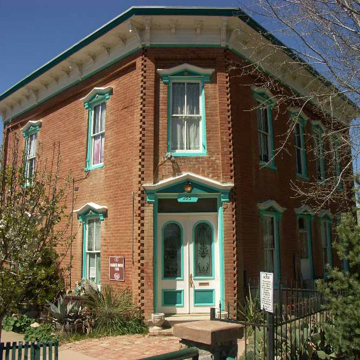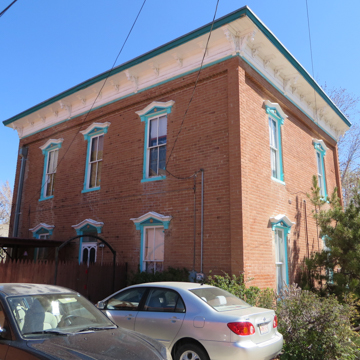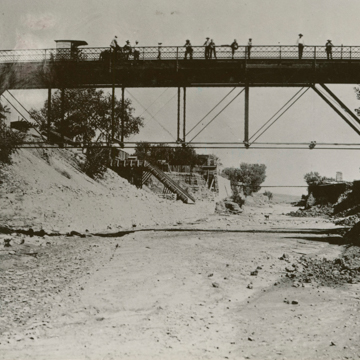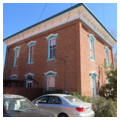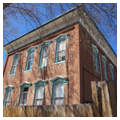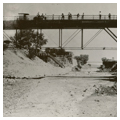The Elizabeth and O.S. Warren House was the residence and initially the office of Elizabeth Warren (1854–1945), a prominent businesswoman and one of the first female building contractors in New Mexico. By 1916, she had been involved in the design, remodeling, and construction of more than fifty dwellings in Silver City.
Elizabeth and Orange Scott Warren settled in Silver City with their three children in 1882, after several years of travel to the Pacific Northwest, Mexico, Central America, South America, and Cuba. O.S. Warren, an insurance and real estate agent, died in 1885, the same year that the family’s two-story brick house was completed on the corner of Market and Main Street.
The Italianate house has a shallow-pitched roof with wide overhanging eaves supported by decorative corbels, door and window openings surmounted by pedimented moldings, doors with arched lights, and smooth wall surfaces accented with patterned quoins at the corners. Other features are more unusual, at least for a single-family residence of the period. The building was chamfered at the intersection of two streets, giving the main entry a diagonal orientation and making the building appear more imposing. Oblique entrances and chamfered corners were more typical of commercial institutions.
Elizabeth Warren took over her husband’s business, which she ran from an office in her house. She was the first woman in New Mexico Territory to become a general insurance agent and a notary public. Warren soon became involved in the Grant County Abstract Company and may have been the first woman in the United States to be the proprietor of a business dealing in property abstracts. By 1900 she had become the most successful insurance agent in the Southwest and was prosperous enough to build a luxurious office near her home. Warren also parlayed her knowledge and experience in the real estate business into acquiring property around the community. In 1902, she purchased a large hotel downtown and turned it into a sanitarium-resort; her holdings also included many other smaller properties.
That same year, Warren’s home and business interests were thrust together in an unexpected and dramatic way. Floods—aggravated by erosion and drought—had begun to cause extensive damage in Silver City during the 1890s, particularly along Main Street. The roadbed was washed away and transformed into an arroyo, crossed by bridges that caused one local newspaper to comment on the downtown’s “Venetian appearance.” Then, in August 1902, a huge flood roared through the town and Main Street acquired the name it has had ever since—“The Big Ditch.” Warren was away at the time, but on her return she was able to organize a workforce to pile hundreds of sandbags at the base of her home.
When a 1907 ordinance mandated that property owners build sidewalks, Warren became involved in the concrete business with Mathilda Koehler, a school principal who had gained experience in concrete from her brother. The pair was so successful that other property owners soon contracted them to build sidewalks. By 1910, Warren was expanding her construction business into building houses. Koehler was the foreman for these projects, supervising a work crew that numbered as many as 300 men. Warren favored came glasswork and Craftsman-inspired interiors, and purchased sawmill equipment so that she could directly fabricate wood products and finishes. The house she built for Harry Lamb at 402 West Sixth Street was the first in Silver City to employ tapestry brick, a textured brick available in a variety of colors which created a polychromatic effect when bonded. Warren also remodeled commercial buildings downtown with plate glass and decorative glass windows.
As annual floods continued to wreak destruction in Silver City, building after building along Main Street either collapsed or had to be demolished. Warren was able to save her house by engaging Koehler and her concrete business work crews to construct stone retaining walls along the banks of the Big Ditch. In 1909, the pair built a flume that drained nearby Yankie Street and subsequently added breakwaters along the roadbed to help shore it up (the retaining walls underneath the Warren house and the flume are visible in a historic photograph dating from c. 1909). These efforts ensured that the house would be the only building on Main Street to survive the disastrous floods of the early twentieth century.
This private residence can be viewed from the street.
References
Berry, Susan and Sharman Apt Russell. Built to Last: An Architectural History of Silver City, New Mexico. Rev. 2nd ed. Silver City: Silver City Museum Society, 1995.
John Harlan Collection. Silver City Museum Archives, Silver City, New Mexico.














